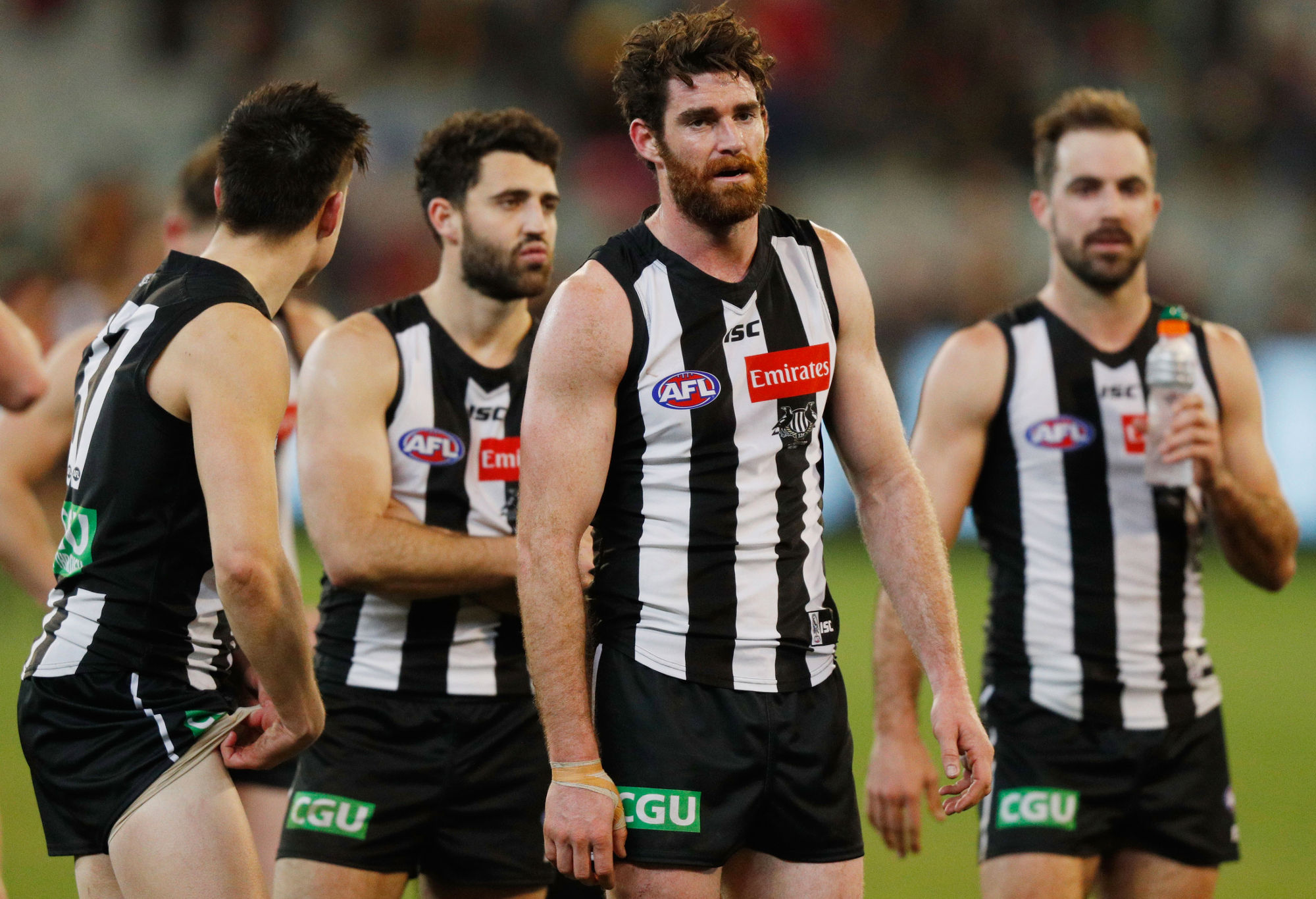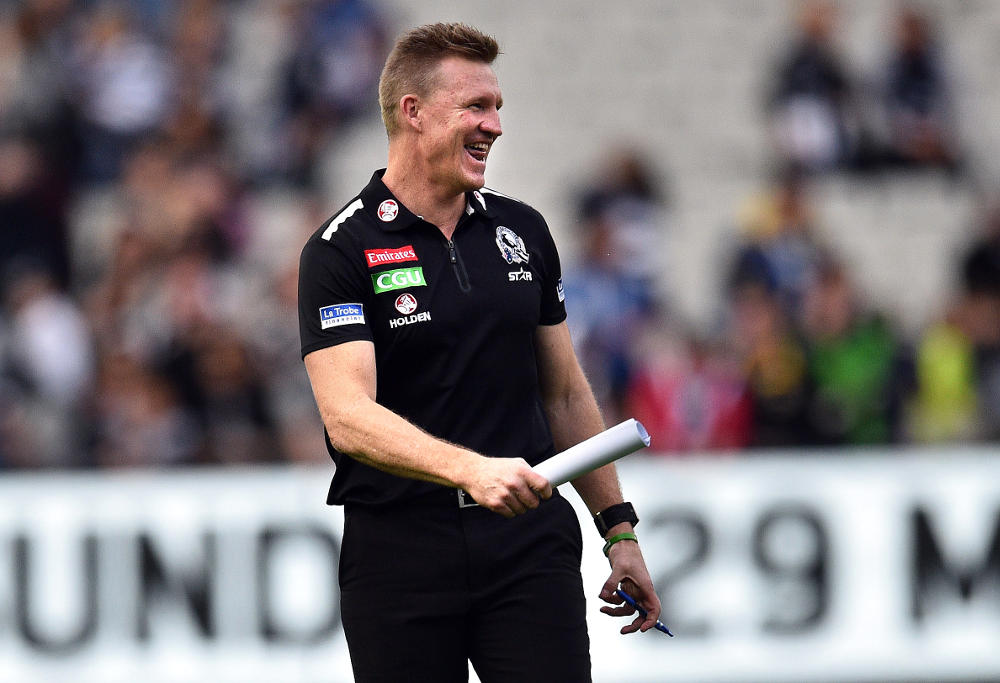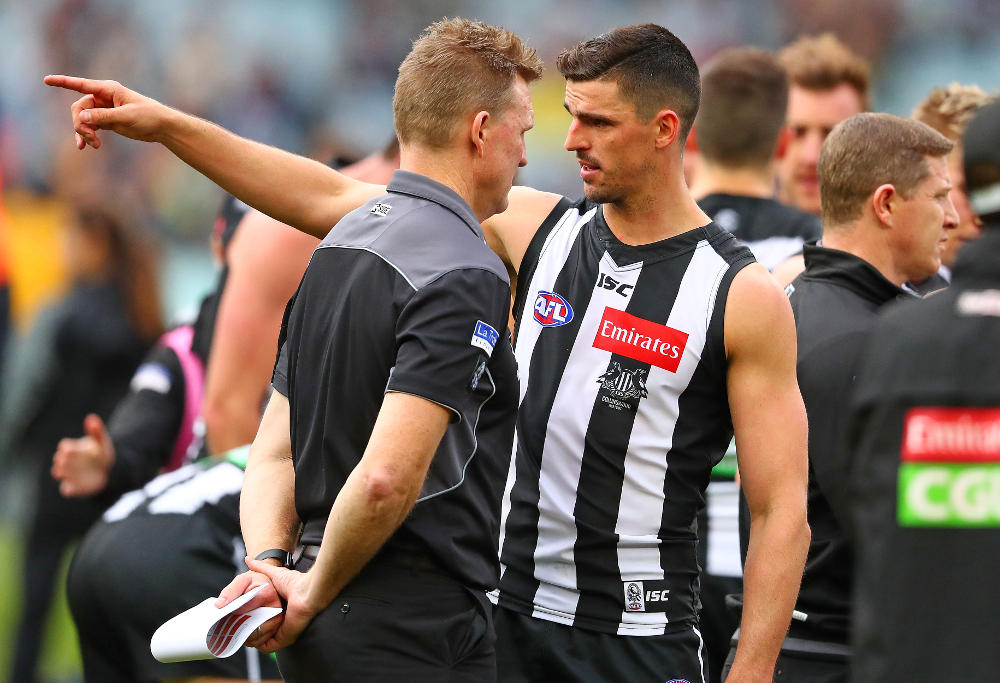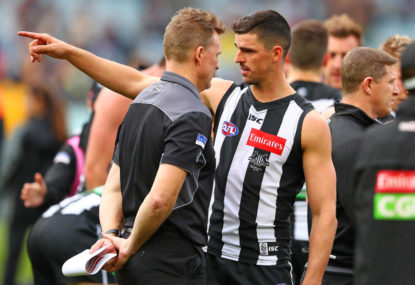Players. You will not get anywhere in football without them. The best coach in the world will do nothing without the right players.
Occasionally, battling sides will get up. They’ll fight on spirit, on ethic, on perseverance, and often it will hold them in good stead … until you get to the pointy end of the season. That’s when class stands out. Many battling teams have been found out come September.
I’ve followed Collingwood since the last 1970s. I watched Tommy Hafey drag hodgepodge teams into grand finals, only to fall painfully and heartbreaking short. I saw Leigh Matthews assemble a strong defensive unit sprinkled with superstars (a side I still believe is underrated) to break Collingwood’s 32-year premiership doubt in 1990 against Essendon.
In 2002-03, Mick Malthouse lifted teams predominantly filled with dour battlers and role-players into successive grand finals against the Brisbane Lions powerhouse, only to fall agonisingly short on one occasion, and be smashed on the other.
I cite history, because it’s important to understand the culture that not only pervades a club, but can also – wittingly or not – govern its evolution. Collingwood was founded from the working class.
They represented the blue collar. They were about the underdog coming good. From the 1920s, their ethic was about playing for the jumper, while losing champions like Ron Todd to better-paying VFA opportunities.
Bob Rose – one of the club’s most celebrated players – retired prematurely from Collingwood in 1956 to captain-coach the Wangaratta Rovers. In 1970, captain Des Tuddenham and vice-captain Len Thompson went on strike because recruit Peter Eakins was being paid $2,000 more than them. In the mid-1980s when they tried to buy up big, they almost bankrupted themselves.
Emerging from the 2002-03 grand final losses, Collingwood’s 04-05 seasons imploded due to a combination of injuries, no doubt mental exhaustion, and recruiting.
While those grand final assaults had been headed by Collingwood champions like Nathan Buckley, James Clement, Anthony Rocca, Scott Burns and Paul Licuria, there wasn’t a lot else coming through the reserves.
Collingwood then had a shift of focus: in 2005, they recruited the flashy and talented Chris Egan. In 2006, they drafted the exciting Dale Thomas and classy Scott Pendlebury.
Several drafts later, it was Steele Sidebottom and Dayne Beams. There seemed a conscious shift in the type of players being brought into the club.
What’s more, purpose drove their recruiting. Outside of adding these talented midfielders and flankers, they drafted a spine in 2006 with Ben Reid, Nathan Brown, and Chris Dawes, who joined Travis Cloke (brought in two years earlier as a father-son). Even rookies such as Heritier Lumumba (nee Harry O’Brien), Alan Toovey, and Sharrod Wellingham had dash about them.
After Collingwood fell short in 2009 – losing to both eventual grand finalists (St Kilda and Geelong) in the finals – they traded for a proven ruck in Darren Jolly, and a hard-ball accumulator in Luke Ball who could feed their other mids.

(Photo by Michael Dodge/Getty Images)
You could see the logic behind every draftee, behind every recruit. You could see the team take form. You could see the way every player complemented their teammate, e.g. in the midfield, you had the rucking of Darren Jolly, Luke Ball feeding the ball out, the class of Pendlebury, the gut-running of Dane Swan, and the dash of Dale Thomas – all different facets of the same midfield.
Most Collingwood supporters will tell you the side that won the 2010 flag, and which dominated the bulk of the 2011 season, is the best, most talented, and skilled Collingwood side they’ve seen.
You can hate Collingwood, but you have to appreciate that the second-half of the drawn grand final aside, they smashed every team they played in the 2010 finals (the Dogs by 62 points; Cats by 41 after leading by 14 goals early in the third quarter; and led St Kilda by 24 points at half-time of the draw). In 2011, they topped the ladder with a percentage of 167.7. They had become a juggernaut.
By all reports, when Nathan Buckley took over, he tried to enact a cultural change. Over the next several years, the likes of Leigh Brown, Luke Ball, Leon Davis, Alan Didak, Ben Johnson, Darren Jolly, Andrew Krakouer, Nick Maxwell, Chris Tarrant, and Alan Toovey retired, and players such as Chris Dawes, Heritier Lumumba, Dayne Beams, Heath Shaw, Dale Thomas, and Sharrod Wellingham were traded out.

(AAP Image/Julian Smith)
Collingwood went from topping up in 2012–13 to trying to build on the run. Now I’m not attempting to explore the merits of the succession plan (which has been done to death) or what may have happened had Mick Malthouse stayed on (we can never know), but to explore Collingwood’s list management through this period, because it’s escaped close scrutiny.
A lot of talent left the club in a short period.
Let’s now look at who came in – in brackets, I’ve listed their eventual fate as of the beginning of 2018.
2011 National Draft
Jackson Paine (pick 50 / GONE)
Corey Gault (pick 65 / GONE)
Jarrod Witts (pick 67 / TRADED to Gold Coast)
2011 Trading
Jamie Elliott (89 games)
Martin Clarke (GONE)
Peter Yagmoor (GONE)
2012 Rookie Draft
Lachlan Smith (GONE)
Marley Williams (TRADED to North Melbourne)
Trent Stubbs (GONE)
Daniel Farmer (GONE)
Caolan Mooney (GONE)
Michael Hartley (GONE)
2012 Free Agents
Quinten Lynch (GONE)
Clinton Young (GONE)
Jordan Russell (GONE)
2012 National Draft
Brodie Grundy (Pick 18 / 83 GAMES)
Ben Kennedy (Pick 19 / TRADED to Melbounre/Delisted)
Tim Broomhead (Pick 20 / 35 GAMES)
Jackson Ramsey (Pick 38 / GONE)
Marley Williams (Rookie Promotion)
2013 Rookie Draft
Kylie Martin (Rookie / GONE)
Sam Dwyer (Rookie / GONE)
Adam Oxley (Rookie / 31 GAMES)
Jack Frost (Rookie / TRADED to Brisbane)
Ben Hudson (Rookie / GONE)
Peter Yagmoor (Rookie / GONE)
Ben Richmond (Alternative Rookie / GONE)
2013 Free Agents
Tony Armstrong (GONE)
2013 Trades
Jesse White (GONE)
Patrick Karnezis (GONE)
Taylor Adams (98 GAMES / 67 GAMES for Collingwood)
2013 National Draft
Matthew Scharenberg (Pick 6 / 14 GAMES )
Nathan Freeman (Pick 10 / 0 GAMES / TRADED to St Kilda)
Tom Langdon (Pick 65 / 58 GAMES)
Jonathan Marsh (77 / GONE)
Sam Dwyer (87 / GONE)
2014 Free Agent
Travis Varcoe (186 GAMES / 48 GAMES for Collingwood)
Levi Greenwood (119 GAMES / 45 GAMES for Collingwood)
2014 National Draft
Jordan de Goey (Pick 5 / 50 GAMES)
Darcy Moore (Pick 9 / 48 GAMES)
Brayden Maynard (30 / 52 GAMES)
Matthew Goodyear (48 / GONE)
2015 Rookie Draft
Michael Manteit (GONE)
Brendan Abbott (GONE)
Mason Cox (21 GAMES)
That’s 43 players (but 45 spots, when you count Sam Dwyer and Marley Williams being promoted from the rookie list) who’ve been secured through drafts, free agency, and trading.
Of those 43 Collingwood has just seven players who can be counted as core players: Jamie Elliott, Brodie Grundy, Taylor Adams, Jordan de Goey, Darcy Moore, Brayden Maynard, and Travis Varcoe – that’s one in six hits.
This figure is also generous: Jamie Elliott, while talented, has often been injured; Varcoe has had his own soft tissue problems; and de Goey is still struggling to cement a spot, although no doubt Collingwood would want him to become a core player.
Players like Matthew Scharenberg, Tim Broomhead, Levi Greenwood, and Tom Langdon, have been in and out of the side, and still haven’t secured a starting position. Maxon Cox and Adam Oxley are longshots.
Also, we should qualify that these overall figures are inflated by including the 2014 National Draft, where Colllingwood would finally seem to have found three mainstays – Moore, de Goey, and Maynard have played consistently since being drafted, and are developing.
Remove them and it’s just three draftees who’ve become starters in Collingwood’s best team from the 36 players accumulated between 2011 – 2013. That’s one in twelve selections they’ve got right, and who presumably will become part of their next premiership assault.
Again, that figure: one in twelve.
Matthew Scharenberg, from the 2013 AFL National Draft, could still come good, but going into his fifth year has played just 14 games. Compare that to the amount of games others selected in the top ten of that draft have played as of the beginning of 2018: Tom Boyd (49), Josh Kelly (84), Jack Billings (67), Marcus Bontempelli (85), Kade Kolodjashni (70), James Aish (56), Luke McDonald (74), Christian Salem (47), and Nathan Freeman (0). Tim Broomhead sits in the same category as Scharenberg – been there a long time, but hasn’t played much and is well behind the curve. In his first game for 2018, he broke his leg.
To be a good side, you need good recruiting. You need talent. Collingwood tried to rebuild – problematically, they did it during a time the two new expansion teams were monopolising the best talent in the country – and instead created a vacuum.

(Photo by Scott Barbour/Getty Images)
It’s not relevant if the guys they traded out never played again as well as they did at Collingwood (because I’m sure somebody will offer that counter). For Collingwood to have remained a good team following 2011, they would’ve needed to bring in players who performed at the same level as those who’d gone out.
For them to rebuild into a genuine premiership contender, they would’ve needed to bring in genuine talent who they could pump game-time into and develop. They’ve done that with just one player: Brodie Grundy.
I am a big fan of Taylor Adams playing as an in-and-under mid feeding the ball out to the likes of Pendlebury, Treloar, etc., but he seems to be constantly used in roles that aren’t maximising his strengths. Jamie Elliott is a gun forward, but has had a lot of injury problems.
Where has Collingwood expected to go with this recruiting?
Worse, there hasn’t appeared to be any methodology to their list management: they have drafted – albeit as a father-son – one genuine KP talent: Darcy Moore. Otherwise, they’ve thrown Hail Marys at the likes of Jonathan Marsh, Jack Frost, Mason Cox, etc.
They have overstocked on midfielders and, in the case of Adam Treloar, arguably overpaid, which has deprived them of early draft picks to replenish talent.
Whereas over the course of 2006 – 2010 you could see that eventual premiership team taking shape, using drafting and trading to fill every line, now Collingwood are relying on makeshift answers, such as Mason Cox at full-forward, Taylor Adams at half-back, Darcy Moore at CHB, or recruiting older players such as Lynden Dunn and Daniel Wells to fill holes. There hasn’t been much reason to the rhyme.
And, finally, a lot of the recruiting seems to have been of players with questionable skills. Some of this is the misfortune of injuries and lack of game-time to good users, such as Matthew Scharenberg, Alex Fasolo, and Jamie Elliott. But Collingwood’s skill woes have been well-documented, and have become the lament of many Collingwood supporters.
This Collingwood squad presently epitomises – if not champions – that battling culture, which is astonishing given their coach was one of the best kicks the game’s ever seen, and is easily one of the best players I’ve seen in my time supporting Collingwood.
Although it’s still early days, Collingwood’s drafting in recent years would seem better, but it’s not difficult to see why the club has struggled, and would continue to struggle given the vacuum they unwittingly created.
This isn’t to absolve Buckley of responsibility for Collingwood’s spasmodic performances, nor is it intended to condemn him. He’s a piece of the big Colingwood puzzle which has failed to yield any meaningful picture since 2010. You have to wonder how the various departments were working together when they were putting together their draft and trade selections.
Richmond famously laid out a blueprint that stipulated the members they expected to achieve and the flag that they intended to win. They were mocked by many. Now they’re the 2017 premiers. Hawthorn has just outlined Hawthorn 2050, a blueprint for what they’re intending to build over the next twenty-three years and the flags they intend – not ‘hope’, but ‘intend’ – to win.
It’s curious who’s been driving the vision behind Collingwood, because, unfortunately, it seems as if they’re making it up as they’ve gone along.
































































































